Daniel Riggs
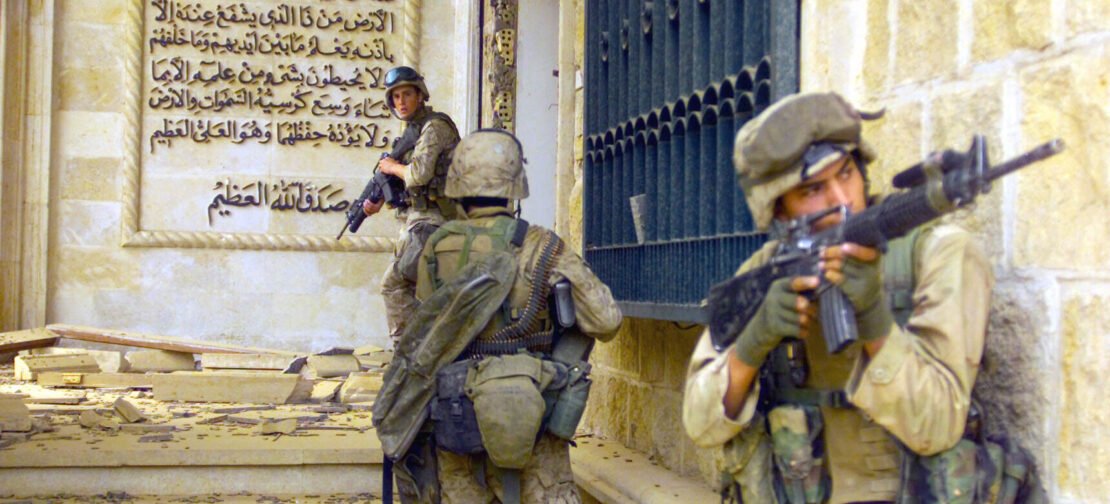
Asymmetrical Warfare: “Unconventional strategies and tactics adopted by a force when the military capabilities of belligerent powers are not simply unequal but are so significantly different that they cannot make the same sorts of attacks on each other.” Encyclopedia Britannica
The Present Asymmetric Orientation
In October 2020, the US Army announced it was going to disband the Asymmetric Warfare Group[i]. Founded in 2003, AWG was formed to counter the improvised explosive device (IED) threat that emerged early in the Iraq War.[ii] AWG was composed of military experts who could use their extensive experience to formulate solutions to problems that were upending deployed units. Until 2012, AWG focused on the atypical means (notably IEDs) in which various insurgencies were preventing US success in both Iraq and Afghanistan.[iii] After 2012, the focus shifted to planning for potential environments soldiers might find themselves in. A recent example of this was AWG training 82nd Airborne paratroopers in subterranean warfare.[iv]
AWG members were innovative at a tactical level, but the group incorrectly defined and oriented its governing term: asymmetry. While they successfully provided symptomatic solutions to threats, they did not posture units or themselves to solve the systemic issues driving the symptoms. If AWG had been a pest control company, it was providing impressive insights on killing termites. However, it had no long-term solution for pests that were affecting the whole property.
The blame should not lie solely with AWG. The past and current strategic orientation to “asymmetry” favors expensive and immediate tactical while ignoring systemic tensions that allow for the asymmetric threat. The strategic orientation put AWG on a Sisyphean Hill without prospect for success. They deserved better direction from higher.
In contrast to the past strategic alignment, strategists must reorient asymmetric thinking to complement and enhance any tactical measures especially in asymmetric environments. Beyond Project Objective Memorandum (POM) cycles[v], contracting, and spending, strategists need to contextualize asymmetric threats radically different than in the past. Alternatively they can continue the current strategy which rewards the enemy, punishes the US populace, and fails to address these ill-structured problems. The following will examine the legacy understanding of asymmetric warfare, the consequences of legacy asymmetric thinking, why this thinking might persist, and considerations for reforming asymmetric thinking at the strategic level.
Modern Roots of the Term
“Asymmetric warfare” emerged as the axiom to explain the environment of the early Iraq conflict. It seemed apropos as the small Iraqi “David” was using their relative size against the US “Goliath” to move, act, and evolve quicker. An internet search of “Asymmetric warfare” appears to corroborate this assumption. Most definitions describe an asymmetric conflict as between weaker opponents frustrating stronger opponents via irregular means. It is a conflict where a jet-ski can frustrate a battleship. The US Iraq experience reflected this appeared to mimic this dictionary definition of a big person being frustrated by the smaller one. In hindsight, strategists should have avoided this definition as it predisposed them to think like a bug exterminator, not as a systemic threat to the bugs. Strategists failed to think asymmetrically like their opponents did. They should have been attempting to dictate the foundational terms of conflict regardless of the opponent’s size, not just trying to spend it away. To redirect thinking on asymmetry, strategists ought to move away from the unsatisfactory “David and Goliath” metaphor.
The starting point is finding a suitable definition to derive subsequent actions and orientations. The Rand Corporation, though far from perfect, provides a suitable starting point: “asymmetric warfare is a conflict between nations or groups that have disparate military capabilities and strategies.”[vi] While not as complete as it should be, this definition provides an opportunity to broadly think about the issue. The latter half of the definition requires keen consideration when it describes “disparate military capabilities and strategies.” The terms “disparate” and “strategies” require special notice and investigation, because they can be the starting terms that guide impactful asymmetric strategy.
Unfortunately, the asymmetric focus defaults to “disparate capabilities”, not “disparate strategies.” This is consequential. Instinctively, it appears that to defeat an adversary’s innovation, extensive resources are required to develop the capabilities to match or overcome it. In the case of IEDs, the US countered insurgent IED emplacement through a myriad of expensive counter IED methods. Rationally, this is Newton’s third law of physics at work. The insurgent’s action necessitated the US countering with an equal reaction. However, the reaction was not equal. It was profoundly in favor of the adversary. They were the ones dictating the conflict and inflicting both seen and unseen consequences on the US.
This was fine for the previous years as it was harmless: none of the US’s adversaries in these conflicts constituted a true existential threat. US Strategists and Planners should care about the future of this term and not relegate it as a tragic designation artifact of the early 2000’s. These failures can be informative. Understanding asymmetry ought to re-emerge to understand and engage in future Great Power Conflict (GPC), not just a Middle Eastern based counter-insurgency. Asymmetric strategic thinking should force planners to think of inverting an adversary’s resources and strengths. Merely trying to out-resource, the adversary’s novel approaches are deleterious and unsustainable.
Rewarding the Enemy: Asymmetry’s First Sin
The Iraq and Afghanistan insurgencies understood a conventional fight would be impossible with the US. What the insurgents needed was to invert the operational environment (OE) to their strengths and then “min-max”[vii] those strengths and metrics for victory. They effectively discovered this equation, defined the variables for victory, and put the US on its back foot. Cheap media and cheaper homemade explosives halted the world’s then sole superpower. Both insurgencies successfully:
Bled the US’ treasure[viii]
Elongated the timeline for any possible victory
Frustrated the patience of a once supportive US domestic populace
The US was in a deficit in these three metrics/variables during these conflicts.
While the US was able to stack bodies of insurgents via direct action, the insurgencies could easily suffer through KIAs if they continued to invert the power paradigm in the conflict. While every killed or captured High Value Individual satisfied a McNamara like vision of victory, it failed to generate US success. GEN Stanley McChrystal best illustrated this in his explanation of “Insurgent Math:”[ix]
Following a military operation, two are killed. How many insurgents are left? Traditional mathematics would say that eight would be left, but there may only be two, because six of the living eight may have said, ‘This business of insurgency is becoming dangerous, so I am going to do something else.’
There are more likely to be as many as 20, because each one you killed has a brother, father, son, and friends, who do not necessarily think that they were killed because they were doing something wrong. It does not matter – you killed them. Suddenly, then, there may be 20, making the calculus of military operations very different.
The USG was aware of this inversion, but failed to divine the variables that would similarly frustrate the insurgency. Strategists instead turned to finance over finesse and foresight.
The development of the Mine Resistant Ambush Protected Vehicle (MRAP) exemplified this reactive turn to the printing presses. Championed by Senator Lindsey Graham[x] and then Senator Joseph Biden[xi], the MRAP was one of the notable solutions to the IED problem. Instead of being in a “soft-skinned” Humvee, soldiers would now ride in seemingly impervious vehicles. While the MRAP undoubtedly saved lives, consider the trade-offs. The more secure MRAP was less mobile and slower than the Humvee. Chasing down a four-door sedan was a problem.
The reaction of insurgents was more inexpensive homemade explosives. Regardless of the protections an armored vehicle offered the insurgents could respond by increasing their spending fractionally, and they did so. The better and bigger IEDs nullified the better and bigger vehicles.[xii] Regardless of the protections offered by Oshkosh, no one is surviving 500-600lbs of explosives beneath your feet.[xiii]
Even more damaging was the cost to the US. The purported MRAP cost as of 2012 was $45 billion dollars.[xiv] The average IED costs around $30.[xv] This divergence is stark. The enemy pays a minuscule sum and consequently exerts disproportionate resource costs upon its opponent. Did the $45 billion dollars spent on the MRAP eliminate the IED threat[xvi] or merely address the symptoms of a problem?
The MRAP is just one example of resource diversion. In fact, IEDs affected the entirety of the Department of Defense’s (DOD) Joint Capabilities Integration Development System (JCIDS). JCIDS is the solution space that considers solutions involving a simulation of doctrine, organization, training, material, leadership and education, personnel, and facilities (DOTMLPF) required to accomplish a mission.[xvii] The table below will show how the IED affected the JCIED’s DOTMLPF process:[xviii]
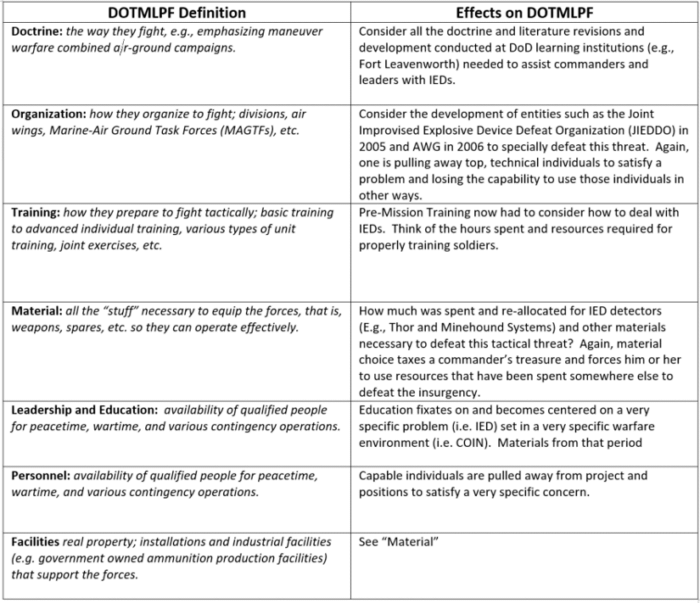

Figure 1: From Author
These small tactical insurgent actions rearranged operational and strategic priorities thus creating an asymmetric relationship. It is not that the insurgent was a smaller opponent with novel means battling a bigger opponent. They imposed disproportionate costs, defined the battlefield, and the metrics for victory. Even if the US is the wealthiest country on earth, there is no such thing as limitless resources. Spending will eventually exceed thresholds and capacities and sink the state. This reactive, money dump failed the US and will continue to do so in future conflicts.
That which is seen and unseen: Domestic Consequences of Asymmetric Thinking
In his seminal text The Law, Frederic Bastiat[xix] encourages economists to look beyond the superficial effect of a law or policy and broaden their perspective to consider secondary and tertiary consequences. His challenge to readers is to divine “seen and unseen” effects from a given choice or policy.[xx] Just like economic concerns, foreign policy problems are not hermetically sealed and solely relegated to the specific geographically defined battlespace. This separation is purely cognitive and incorrect.
Strategists need to acquaint themselves with Bastiat’s lessons[xxi] as much as they do Clausewitz. They have a moral obligation to consider the unseen effects of current reactive measures towards asymmetric threats, and the effect on those it intends to safeguard, the domestic populace. The aforementioned MRAPs not only decreased soldier speed and lethality, but it increased costs, served as a bigger, more notable target, and negatively affected the domestic populace. In terms of the latter, the historic spending[xxii] has led to resource deprivations and inflation directly affecting much of the US population.
Regarding the resource deprivation, consider expert personnel shortages (i.e., scientific, and technical experts) needed to fill the organizations charged to deal with the asymmetric threats. DoD has had to go to the private sector for these solutions. Even before the Global War on Terror (GWOT), approximately one-third to two-thirds of all technical researchers in the United States have been working for the military.[xxiii] The consequence is a reduced supply of comparable talent to serve civilian industry and civilian activities[xxiv] According to one study, the DoD luring science and engineering graduates with high salaries has reduced the quantity and quality of R&D undertaken in civilian-created laboratories[xxv] The US domestic populace (and the world population) might be missing out on technological and medical breakthroughs as civilian institutions do not have the personnel to move projects out of a nascent stage or towards completion.
Inflation is another destabilizing effect of the current asymmetric “capabilities” posture against the populace. When DoD needs funding that is in excess of tax revenues, they need to recall where money comes from. Strategists need to remember increased printing of dollars via the US Federal Reserve (aka the Fed) is not just an ink and paper cost. The Fed’s printing of excess dollars (i.e. dollars that are not reflecting and representative of new capital creation) leads to a chase of too few goods, which requires more dollars to purchase the product. This disproportionately affects lower and middle income families who bear an increase in prices of goods (especially food and energy), that is easier to offset for the rich.[xxvi] These demographics remain stagnant while the upper classes in society continue to rise. This trend, which has been increasing for some time[xxvii] and exacerbated by financial commitments to these conflicts, is not desirable for an aspirational stable society and past research indicates it leads to unstable societies.[xxviii] Any spurious claim of being safer from this spending needs to juxtapose it against a volatile society with a widening distribution of wealth.
Why Strategists Stumble Asymmetrically
What might explain this limited mindset that leads to these consequences? There has been much written about the difficulty grooming and selecting strategic planners within the military. One critic notes those who rise to the top of the strategic decision-making pyramid are poorly qualified for the task[xxix] due to a personnel system that bases promotions on tactical competence over the first quarter century of an officer’s career.[xxx] Unfortunately, tactical skill does equate or translate to great strategic skill and are often incongruous mindsets.[xxxi] It makes sense why a reactionary tactical approach manifests at the strategic level[xxxii] as it has served that leader well in the past.
Even more than this, structural critiques are a fundamental human reason. Amos Tversky and Daniel Kahneman could explain the strategic creativity deficit due to “Loss Aversion.” Within greater prospect theory, “Loss Aversion” postulates that the pain of losing psychologically motivates people’s behavior as twice as powerful as the pleasure of gaining.[xxxiii] When people do take risks, it is more likely to avoid a loss than to make a gain people are more willing to take risks (i.e., losses loom larger than gains).[xxxiv] In the case of asymmetric thinking, one can better avoid a loss by spending money to mitigate a problem. A plan to put an opponent in an asymmetric relationship just carries more risks, because innovation requires change and risk. Someone looking at their career progression might elect for something more rational with a stronger reward guarantee.
These impediments do not necessarily prevent a successful asymmetric strategy; however, flag officers and strategists must identify and account for them in order to ensure they don’t subvert necessary and proper strategy. After this, a radical rethinking and restructuring can occur to tackle asymmetric threats. If not, we see from the past conflicts advantages gained by the enemy and punishment to the domestic populace.
Orientating Asymmetric Thinking towards GPC
The following will not be an ambitious conception of re-building of strategy. Instead it will advocate for the incorporation of certain principles to better assist strategists conceive of asymmetric opportunities with GPCs or any other adversary.
Tensions
Center of Gravity (COG) analysis informs current problem framing in joint doctrine with its constituent vulnerabilities, requirements, and capabilities.[xxxv] While appropriate for force on force, COG should not influence asymmetric planning. As an analytical tool, COG inevitably frames an adversary in a “blue on red” context, which will push planners back to a symmetrical understanding of conflict and options in it.
COG’s narrow conception of the environment fails to deal with the complexity that is an inherent aspect of an asymmetric environment. Instead of a channelized conception of weaknesses, looking at systemic tensions provides strategists a perspective which generates options to deal with an adversary. While abstract, systemic tensions provide a means to appreciate and understand the most significant and influential phenomena within a given environment that would contribute to an end state.[xxxvi]
Dr. Ben Zweibelson documented this in his role as a planning lead for the NATO Training Mission-Afghanistan/Combined Security Transition Command-Afghanistan (NTM-A/CSTC-A). To better assist commanders and planners better understand the complexity of Afghanistan through radical recalibration in 2011, Zweibelson and his team followed a four step process consisting of (1) de-taciticalization,[xxxvii] (2) contextualization,[xxxviii] (3) problematization,[xxxix] and (4) improvisation.[xl] The eventual deliverables were a series of operational level frames for planners that emancipated them for merely conceiving of conflict solely within operational level variables (aka PMESII-PT).
The problematization step especially provides one of the better ideas for thinking asymmetrically. In this step, and seen in Zweibelsons work,[xli] strategists juxtapose oppositional tensions against each other on quad charts to spur future planning, redirect on-going operations, and/or re-frame a post conflict future to gain insights not previously divined.[xlii]
In the case of China in a GPC conflict, consider the initial hypotheses of possible competing tensions within China that could yield asymmetric insights:
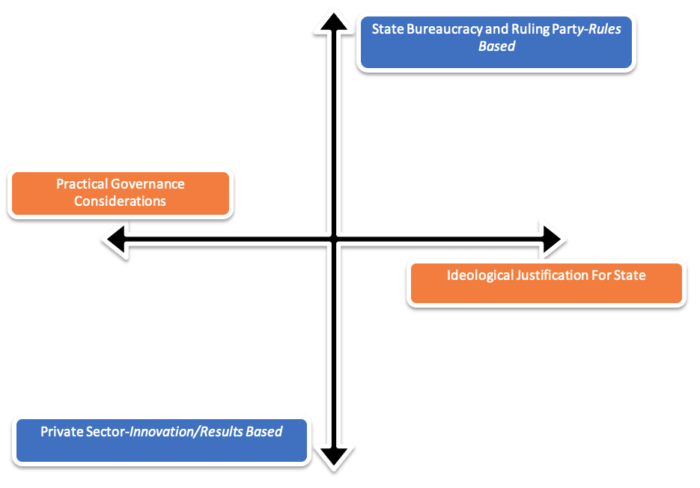
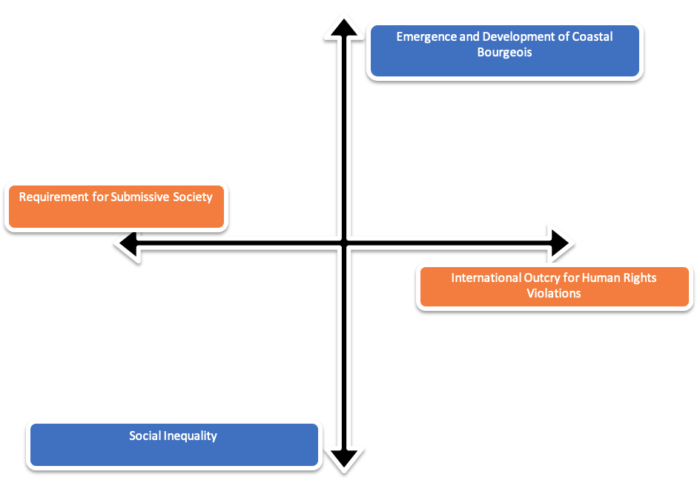
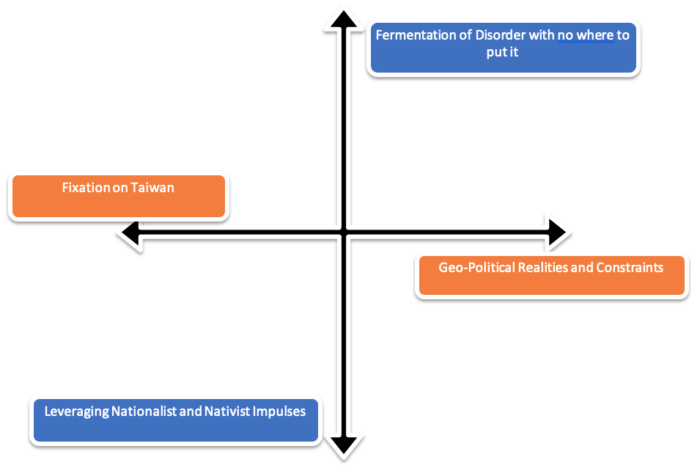
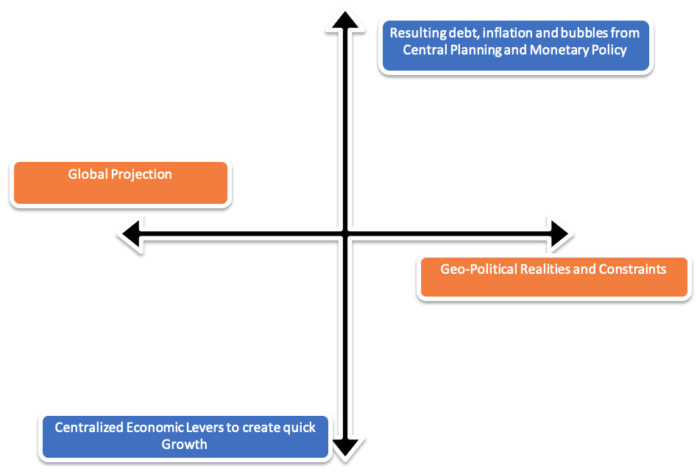
As one can see across the four examples, the tension charts kick start thinking not of course of action development. Over a longer period and with more participants, these initial quads would see the tensions re-arranged, introducing an addition of changing descriptive words and metaphoric images in the effort to divine asymmetries. The result would be a break from the paradigm of a classic great power struggle defined solely by capabilities, instead of a singular focus on a COG to generate options.
Value
Just as strategists should look to Bastiat for guidance, they should also look to economists such as Carl Menger, William Jevons, and Leon Walras. Within a few years of one another, these three economists posited value derived from utility, not from labor.[xliii] In overturning this Marxist proposition and simultaneously answering the “diamond-water paradox”[xliv] that had bedeviled Adam Smith, Menger et al argued that value is completely subjective.[xlv] The ability to satisfy human wants, accessibility (is it scarce or in abundance) and utility in its least important uses dictates a product’s value.[xlvi] Value is thus reflective of the continuous and relative judegments men make to maintain the requirements for their lives and well-being.”[xlvii] Value formation is a specific iterative process, not something that is a priori or determined by the “world of the forms.”
This value description is not tangential but critical for thinking asymmetrically. Current Joint Doctrine asks planners to understand value in terms of a static, quantifiable, and utilitarian sense (see Jeremy Bentham’s work on his conception of utility) that will yield a definable output.[xlviii] This understanding of value fails to understand the dynamic nature of value. It accepts an objective and utilitarian sense of value. The consequence of this is it sees value as fixed and requires a positivist means to validate it.
If strategists have this objective and utilitarian sense of value, they end up with a lens that defaults all conflict to a linear conflict, not asymmetric where more amorphous and unmeasurable concepts in the cognitive realm are of importance. The targeting of what is valuable to the adversary becomes the biased reflection of the Professional Military Education taught to strategists, not what is of value at that time and space to the adversary. It is easy to see how this misperception is consequential as it undoubtedly leads to resource misallocation and faulty objectives.
In the case of Vietnam, the misconception of value and tensions were on full display and assisted in defeat. Robert McNamara’s penchant for objective measurement failed to discern the operational level variables requisite for success. In the aggregate, these measurements of progress, established at the highest levels, failed to tell the story of what was happening in the ground[xlix] and resulted in outputs understood in absolute terms[l] without the clarity of nuance.
As noted in Douglas Kinnard’s The War Managers, what precisely did “37% of camps neutralized” mean.[li] How was that effective for US forces and deleterious for North Vietnam? GEN William Westmoreland remarked that the US failed to understand the motivations and perspective of the enemy.[lii] In a way, planners assumed what was of value to the enemy and ignored tensions in both North and South Vietnam that they needed to address or target. Instead, strategists conceived of the conflict consisted as two “symmetrical forces who valued the same things.”
A dynamic understanding of value is required to think asymmetrically. Failing to understand what is of value, not just monetarily and not necessarily measurable, to key adversary decision makers and influencers makers, likely means a return to a fixed and unhelpful conception of power in a GPC relationship. To defeat a peer adversary with equal resources, requires the means to deplete their ability to earn or sustain value.
Future Asymmetric Warfare Group
Asymmetry’s current orientation and subsequent responses have been ineffective and damaging to the larger US society. Strategists owe the US citizenry better. The future of Asymmetry must be radical and proactive, not a reactive spending spree. If DoD is dealing with a traditional GPC opponent, the US is not going to be able to outspend it. Future asymmetric planners need to exact disproportionate costs[liii] on the enemy by better identifying systemic tensions and what is of value to the adversary decision makers within their time and space. Future research ought to articulate a methodology that provides a framework to help strategists think more radically. The motto of AWG was Think. Adapt. Anticipate. The new motto should be the following: Clarify. Design. Subvert.
No comments:
Post a Comment